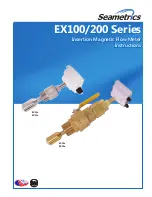
EX100/200 SERIES INSTRUCTIONS
Seametrics • 253.872.0284
Page 15 seametrics.com
Flow Rates
(in gallons per minute)
OPERATION & MAINTENANCE
Filtering
The software of the EX100/200-Series filters out electrical
noise and averages sudden variations in the flow to smooth
the output. It takes a matter of seconds for the flow sensor
to get up to full output when it is powered up or when flow
begins.
Electrode Coating
Grease or other adhering, non-conductive materials can
stop flow detection if the electrodes become heavily
coated. To clean the electrodes, remove the sensor from
the pipe and gently scrub the electrodes (three silver
bumps) on the reading face of the flow sensor. A mild soap
(dishwashing liquid for example) can be used to aid the
cleaning process.
Calibration (“K-Factor”)
In order to properly process pulses from the flow sensor,
a number must be entered into the control to which the
sensor is connected. This number, called the K-factor,
is the number of pulses the sensor puts out per unit of
fluid passing through the pipe. It is normally provided
for Seametrics sensors in pulses per gallon, and can be
ascertained by using the “K-Factor Calculator” on the
Seametrics website. These numbers are based on extensive
testing, which has shown close agreement among different
EX sensors in the same installation. Typically, most K-factor
error can be attributed to installation variables, such as
depth setting and fitting configuration.
Zero Adjustment
When the EX100/200-Series meter is powered up and
there is no flow, there should be no output pulses (or, if
connected to the FT430/440, flow rate should read “0”). If
there are pulses, it may be necessary to adjust the flow
meter under no-flow conditions after it has been installed.
This should only be done if the indicated flow is low,
near the lower cutoff.
Zero Adjustment
To perform the adjustment, after determining that there
is a full pipe with no flow, short between the two pins
marked “Zero Adjust”. A red LED light will come on for
approximately 50 seconds and then go out. The zero
adjustment is completed.
Minimum Flow
As with any other flow sensor, there is a rate below which
the EX100-Series sensor cannot read. Check the table
below for the minimum flow rate detectable by the sensor
for a given pipe size.
Presence of Flow Indication.
To assist in troubleshooting,
the “Status LED” has two blinking modes in normal
operation. When there is no flow detectable by the meter
(below minimum threshold) the LED blinks every 8.0
seconds. When there is detectable flow, the same indicator
blinks every 3.0 seconds (Pulses are being output when
indicator is blinking every 3 seconds).
30Vdc
Max. 6mA
- +
- +
12-24Vdc
3
4
5
6
2
1
Power
Forward
Output
Status
LED
Zero
Adjust
Pins
Zero
Adjust
Pins
Status
LED
Using the K-Factor Calculator:
Go to
seametrics.com
and select the
K-factor Calculator
located at the bottom of the home page*.
1. Select your meter.
2. Choose units.
3. Input external pipe diameter (measure) and
wall thickness (measure, or look-up in Pipe Wall
Thickness table on page 8 of this manual).
4. Press Calculate to determine your K-factor.
(
NOTE:
Dimension D is also calculated.)
5. Enter your K-factor into your controller.
*For pipe sizes larger than 50”, please consult factory.
Feet
Per
Second
Nominal Pipe Size
3”
4”
6”
8”
10”
12”
14”
16”
18”
20”
24”
30”
36”
48”
Min
0.28
6
11
25
44
69
99
134
175
222
274
395
617
888
1,580
Max
20.0
440
783
1,762
3,133
4,895
7,050
9,596
12,533
15,863
19,584
28,200
44,064
63,452
112,804




















